Analyzing Stereotypes, Biases, and Diversity in the Workplace Context
VerifiedAdded on 2020/06/04
|13
|4420
|54
Homework Assignment
AI Summary
This assignment addresses key issues related to diversity and inclusion in the workplace. It begins by defining stereotype threat and exploring strategies managers can use to mitigate its impact, emphasizing the role of role models, motivational sessions, and fostering a respectful environment. The assignment then examines various ways biases and stereotypes manifest against women, including descriptive and prescriptive biases, and how these can influence their opportunities. It also delves into the concept of stigma, particularly concerning employees with disabilities, and how it affects their acceptance and integration within the workplace. Furthermore, the assignment explores the potential effects of ethnic and religious markers on job applications, highlighting discriminatory practices and unconscious biases. Finally, it discusses the effectiveness of gender quotas on boards of directors as a means of increasing female representation in senior leadership positions, examining arguments for and against such policies.
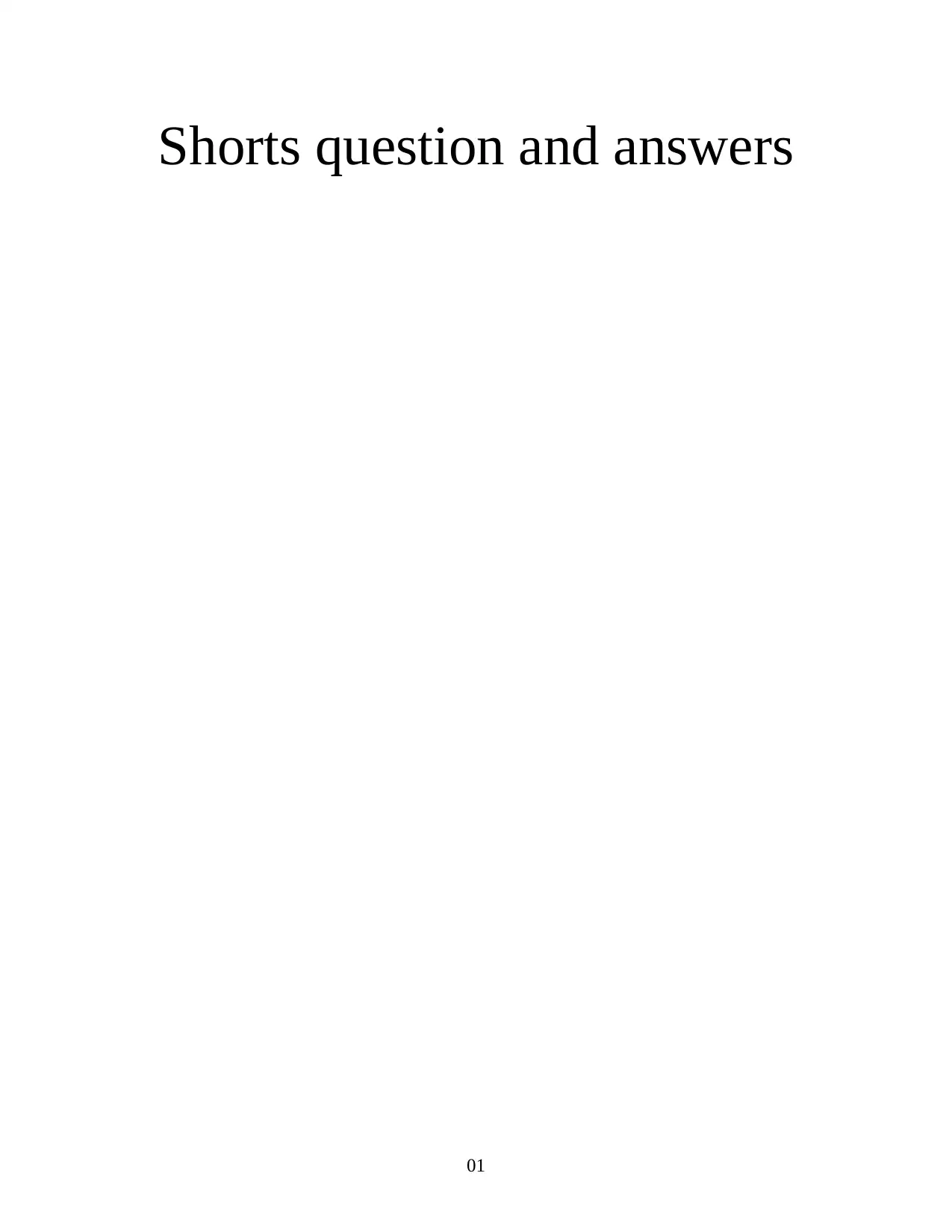
Shorts question and answers
01
01
Paraphrase This Document
Need a fresh take? Get an instant paraphrase of this document with our AI Paraphraser
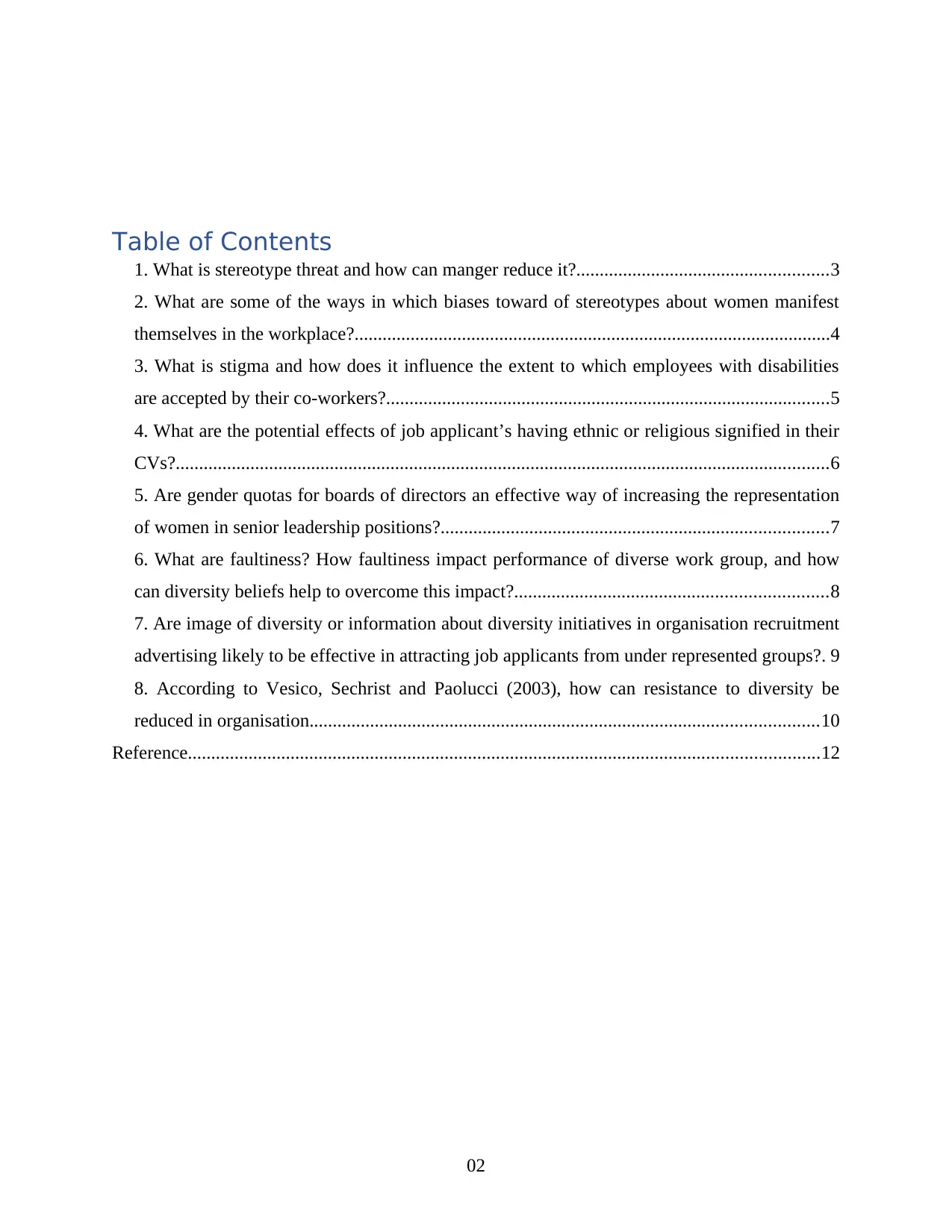
Table of Contents
1. What is stereotype threat and how can manger reduce it?......................................................3
2. What are some of the ways in which biases toward of stereotypes about women manifest
themselves in the workplace?......................................................................................................4
3. What is stigma and how does it influence the extent to which employees with disabilities
are accepted by their co-workers?...............................................................................................5
4. What are the potential effects of job applicant’s having ethnic or religious signified in their
CVs?............................................................................................................................................6
5. Are gender quotas for boards of directors an effective way of increasing the representation
of women in senior leadership positions?...................................................................................7
6. What are faultiness? How faultiness impact performance of diverse work group, and how
can diversity beliefs help to overcome this impact?...................................................................8
7. Are image of diversity or information about diversity initiatives in organisation recruitment
advertising likely to be effective in attracting job applicants from under represented groups?. 9
8. According to Vesico, Sechrist and Paolucci (2003), how can resistance to diversity be
reduced in organisation.............................................................................................................10
Reference.......................................................................................................................................12
02
1. What is stereotype threat and how can manger reduce it?......................................................3
2. What are some of the ways in which biases toward of stereotypes about women manifest
themselves in the workplace?......................................................................................................4
3. What is stigma and how does it influence the extent to which employees with disabilities
are accepted by their co-workers?...............................................................................................5
4. What are the potential effects of job applicant’s having ethnic or religious signified in their
CVs?............................................................................................................................................6
5. Are gender quotas for boards of directors an effective way of increasing the representation
of women in senior leadership positions?...................................................................................7
6. What are faultiness? How faultiness impact performance of diverse work group, and how
can diversity beliefs help to overcome this impact?...................................................................8
7. Are image of diversity or information about diversity initiatives in organisation recruitment
advertising likely to be effective in attracting job applicants from under represented groups?. 9
8. According to Vesico, Sechrist and Paolucci (2003), how can resistance to diversity be
reduced in organisation.............................................................................................................10
Reference.......................................................................................................................................12
02
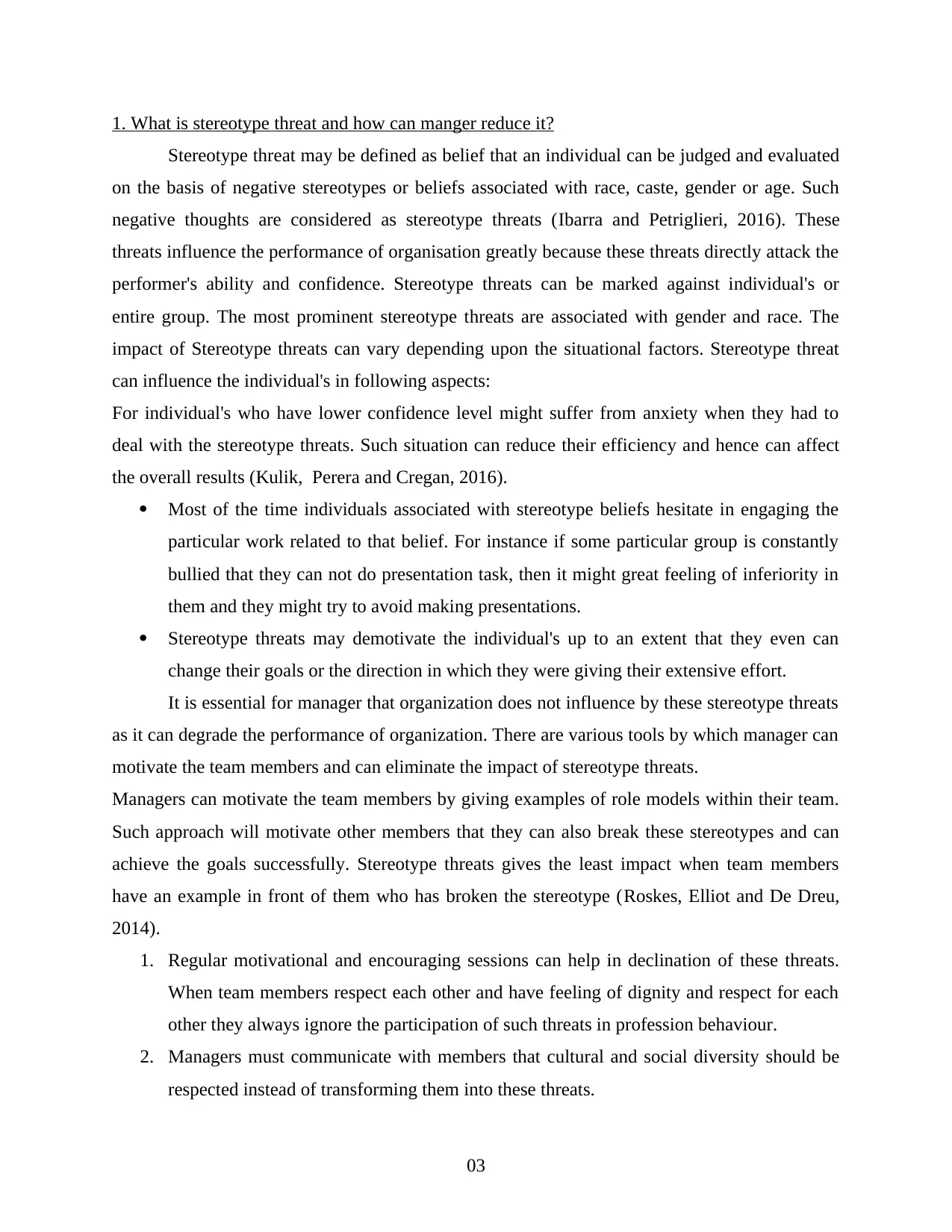
1. What is stereotype threat and how can manger reduce it?
Stereotype threat may be defined as belief that an individual can be judged and evaluated
on the basis of negative stereotypes or beliefs associated with race, caste, gender or age. Such
negative thoughts are considered as stereotype threats (Ibarra and Petriglieri, 2016). These
threats influence the performance of organisation greatly because these threats directly attack the
performer's ability and confidence. Stereotype threats can be marked against individual's or
entire group. The most prominent stereotype threats are associated with gender and race. The
impact of Stereotype threats can vary depending upon the situational factors. Stereotype threat
can influence the individual's in following aspects:
For individual's who have lower confidence level might suffer from anxiety when they had to
deal with the stereotype threats. Such situation can reduce their efficiency and hence can affect
the overall results (Kulik, Perera and Cregan, 2016).
Most of the time individuals associated with stereotype beliefs hesitate in engaging the
particular work related to that belief. For instance if some particular group is constantly
bullied that they can not do presentation task, then it might great feeling of inferiority in
them and they might try to avoid making presentations.
Stereotype threats may demotivate the individual's up to an extent that they even can
change their goals or the direction in which they were giving their extensive effort.
It is essential for manager that organization does not influence by these stereotype threats
as it can degrade the performance of organization. There are various tools by which manager can
motivate the team members and can eliminate the impact of stereotype threats.
Managers can motivate the team members by giving examples of role models within their team.
Such approach will motivate other members that they can also break these stereotypes and can
achieve the goals successfully. Stereotype threats gives the least impact when team members
have an example in front of them who has broken the stereotype (Roskes, Elliot and De Dreu,
2014).
1. Regular motivational and encouraging sessions can help in declination of these threats.
When team members respect each other and have feeling of dignity and respect for each
other they always ignore the participation of such threats in profession behaviour.
2. Managers must communicate with members that cultural and social diversity should be
respected instead of transforming them into these threats.
03
Stereotype threat may be defined as belief that an individual can be judged and evaluated
on the basis of negative stereotypes or beliefs associated with race, caste, gender or age. Such
negative thoughts are considered as stereotype threats (Ibarra and Petriglieri, 2016). These
threats influence the performance of organisation greatly because these threats directly attack the
performer's ability and confidence. Stereotype threats can be marked against individual's or
entire group. The most prominent stereotype threats are associated with gender and race. The
impact of Stereotype threats can vary depending upon the situational factors. Stereotype threat
can influence the individual's in following aspects:
For individual's who have lower confidence level might suffer from anxiety when they had to
deal with the stereotype threats. Such situation can reduce their efficiency and hence can affect
the overall results (Kulik, Perera and Cregan, 2016).
Most of the time individuals associated with stereotype beliefs hesitate in engaging the
particular work related to that belief. For instance if some particular group is constantly
bullied that they can not do presentation task, then it might great feeling of inferiority in
them and they might try to avoid making presentations.
Stereotype threats may demotivate the individual's up to an extent that they even can
change their goals or the direction in which they were giving their extensive effort.
It is essential for manager that organization does not influence by these stereotype threats
as it can degrade the performance of organization. There are various tools by which manager can
motivate the team members and can eliminate the impact of stereotype threats.
Managers can motivate the team members by giving examples of role models within their team.
Such approach will motivate other members that they can also break these stereotypes and can
achieve the goals successfully. Stereotype threats gives the least impact when team members
have an example in front of them who has broken the stereotype (Roskes, Elliot and De Dreu,
2014).
1. Regular motivational and encouraging sessions can help in declination of these threats.
When team members respect each other and have feeling of dignity and respect for each
other they always ignore the participation of such threats in profession behaviour.
2. Managers must communicate with members that cultural and social diversity should be
respected instead of transforming them into these threats.
03
⊘ This is a preview!⊘
Do you want full access?
Subscribe today to unlock all pages.

Trusted by 1+ million students worldwide
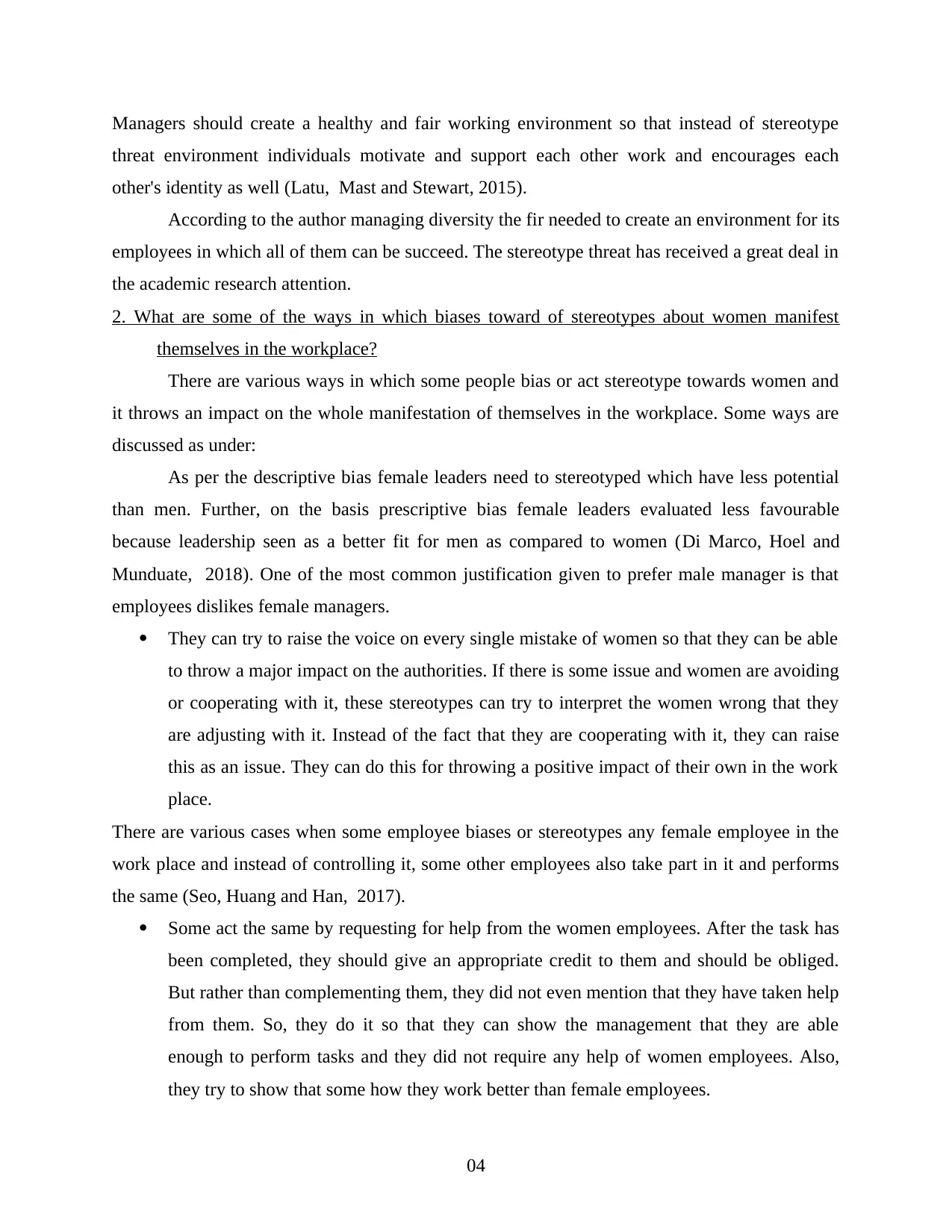
Managers should create a healthy and fair working environment so that instead of stereotype
threat environment individuals motivate and support each other work and encourages each
other's identity as well (Latu, Mast and Stewart, 2015).
According to the author managing diversity the fir needed to create an environment for its
employees in which all of them can be succeed. The stereotype threat has received a great deal in
the academic research attention.
2. What are some of the ways in which biases toward of stereotypes about women manifest
themselves in the workplace?
There are various ways in which some people bias or act stereotype towards women and
it throws an impact on the whole manifestation of themselves in the workplace. Some ways are
discussed as under:
As per the descriptive bias female leaders need to stereotyped which have less potential
than men. Further, on the basis prescriptive bias female leaders evaluated less favourable
because leadership seen as a better fit for men as compared to women (Di Marco, Hoel and
Munduate, 2018). One of the most common justification given to prefer male manager is that
employees dislikes female managers.
They can try to raise the voice on every single mistake of women so that they can be able
to throw a major impact on the authorities. If there is some issue and women are avoiding
or cooperating with it, these stereotypes can try to interpret the women wrong that they
are adjusting with it. Instead of the fact that they are cooperating with it, they can raise
this as an issue. They can do this for throwing a positive impact of their own in the work
place.
There are various cases when some employee biases or stereotypes any female employee in the
work place and instead of controlling it, some other employees also take part in it and performs
the same (Seo, Huang and Han, 2017).
Some act the same by requesting for help from the women employees. After the task has
been completed, they should give an appropriate credit to them and should be obliged.
But rather than complementing them, they did not even mention that they have taken help
from them. So, they do it so that they can show the management that they are able
enough to perform tasks and they did not require any help of women employees. Also,
they try to show that some how they work better than female employees.
04
threat environment individuals motivate and support each other work and encourages each
other's identity as well (Latu, Mast and Stewart, 2015).
According to the author managing diversity the fir needed to create an environment for its
employees in which all of them can be succeed. The stereotype threat has received a great deal in
the academic research attention.
2. What are some of the ways in which biases toward of stereotypes about women manifest
themselves in the workplace?
There are various ways in which some people bias or act stereotype towards women and
it throws an impact on the whole manifestation of themselves in the workplace. Some ways are
discussed as under:
As per the descriptive bias female leaders need to stereotyped which have less potential
than men. Further, on the basis prescriptive bias female leaders evaluated less favourable
because leadership seen as a better fit for men as compared to women (Di Marco, Hoel and
Munduate, 2018). One of the most common justification given to prefer male manager is that
employees dislikes female managers.
They can try to raise the voice on every single mistake of women so that they can be able
to throw a major impact on the authorities. If there is some issue and women are avoiding
or cooperating with it, these stereotypes can try to interpret the women wrong that they
are adjusting with it. Instead of the fact that they are cooperating with it, they can raise
this as an issue. They can do this for throwing a positive impact of their own in the work
place.
There are various cases when some employee biases or stereotypes any female employee in the
work place and instead of controlling it, some other employees also take part in it and performs
the same (Seo, Huang and Han, 2017).
Some act the same by requesting for help from the women employees. After the task has
been completed, they should give an appropriate credit to them and should be obliged.
But rather than complementing them, they did not even mention that they have taken help
from them. So, they do it so that they can show the management that they are able
enough to perform tasks and they did not require any help of women employees. Also,
they try to show that some how they work better than female employees.
04
Paraphrase This Document
Need a fresh take? Get an instant paraphrase of this document with our AI Paraphraser
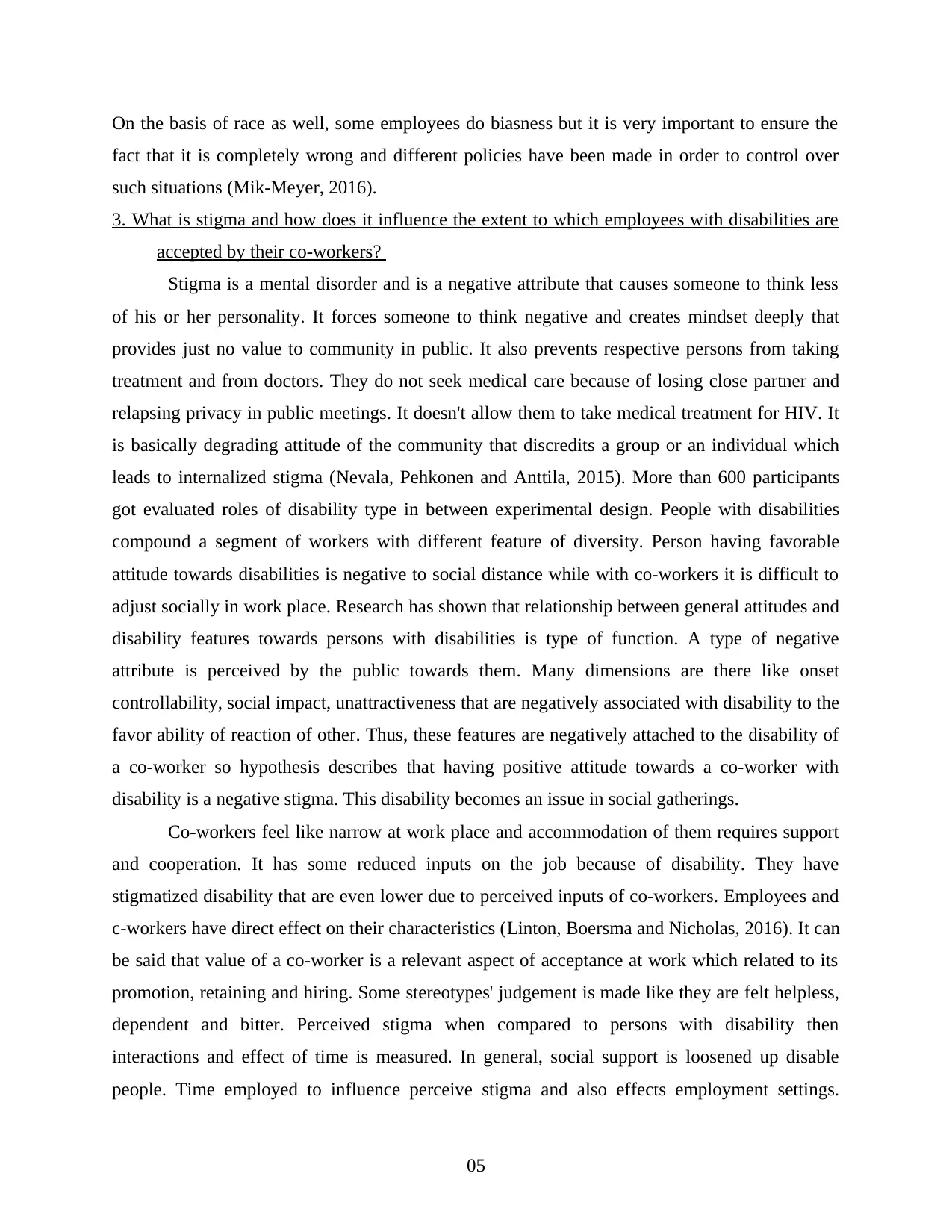
On the basis of race as well, some employees do biasness but it is very important to ensure the
fact that it is completely wrong and different policies have been made in order to control over
such situations (Mik-Meyer, 2016).
3. What is stigma and how does it influence the extent to which employees with disabilities are
accepted by their co-workers?
Stigma is a mental disorder and is a negative attribute that causes someone to think less
of his or her personality. It forces someone to think negative and creates mindset deeply that
provides just no value to community in public. It also prevents respective persons from taking
treatment and from doctors. They do not seek medical care because of losing close partner and
relapsing privacy in public meetings. It doesn't allow them to take medical treatment for HIV. It
is basically degrading attitude of the community that discredits a group or an individual which
leads to internalized stigma (Nevala, Pehkonen and Anttila, 2015). More than 600 participants
got evaluated roles of disability type in between experimental design. People with disabilities
compound a segment of workers with different feature of diversity. Person having favorable
attitude towards disabilities is negative to social distance while with co-workers it is difficult to
adjust socially in work place. Research has shown that relationship between general attitudes and
disability features towards persons with disabilities is type of function. A type of negative
attribute is perceived by the public towards them. Many dimensions are there like onset
controllability, social impact, unattractiveness that are negatively associated with disability to the
favor ability of reaction of other. Thus, these features are negatively attached to the disability of
a co-worker so hypothesis describes that having positive attitude towards a co-worker with
disability is a negative stigma. This disability becomes an issue in social gatherings.
Co-workers feel like narrow at work place and accommodation of them requires support
and cooperation. It has some reduced inputs on the job because of disability. They have
stigmatized disability that are even lower due to perceived inputs of co-workers. Employees and
c-workers have direct effect on their characteristics (Linton, Boersma and Nicholas, 2016). It can
be said that value of a co-worker is a relevant aspect of acceptance at work which related to its
promotion, retaining and hiring. Some stereotypes' judgement is made like they are felt helpless,
dependent and bitter. Perceived stigma when compared to persons with disability then
interactions and effect of time is measured. In general, social support is loosened up disable
people. Time employed to influence perceive stigma and also effects employment settings.
05
fact that it is completely wrong and different policies have been made in order to control over
such situations (Mik-Meyer, 2016).
3. What is stigma and how does it influence the extent to which employees with disabilities are
accepted by their co-workers?
Stigma is a mental disorder and is a negative attribute that causes someone to think less
of his or her personality. It forces someone to think negative and creates mindset deeply that
provides just no value to community in public. It also prevents respective persons from taking
treatment and from doctors. They do not seek medical care because of losing close partner and
relapsing privacy in public meetings. It doesn't allow them to take medical treatment for HIV. It
is basically degrading attitude of the community that discredits a group or an individual which
leads to internalized stigma (Nevala, Pehkonen and Anttila, 2015). More than 600 participants
got evaluated roles of disability type in between experimental design. People with disabilities
compound a segment of workers with different feature of diversity. Person having favorable
attitude towards disabilities is negative to social distance while with co-workers it is difficult to
adjust socially in work place. Research has shown that relationship between general attitudes and
disability features towards persons with disabilities is type of function. A type of negative
attribute is perceived by the public towards them. Many dimensions are there like onset
controllability, social impact, unattractiveness that are negatively associated with disability to the
favor ability of reaction of other. Thus, these features are negatively attached to the disability of
a co-worker so hypothesis describes that having positive attitude towards a co-worker with
disability is a negative stigma. This disability becomes an issue in social gatherings.
Co-workers feel like narrow at work place and accommodation of them requires support
and cooperation. It has some reduced inputs on the job because of disability. They have
stigmatized disability that are even lower due to perceived inputs of co-workers. Employees and
c-workers have direct effect on their characteristics (Linton, Boersma and Nicholas, 2016). It can
be said that value of a co-worker is a relevant aspect of acceptance at work which related to its
promotion, retaining and hiring. Some stereotypes' judgement is made like they are felt helpless,
dependent and bitter. Perceived stigma when compared to persons with disability then
interactions and effect of time is measured. In general, social support is loosened up disable
people. Time employed to influence perceive stigma and also effects employment settings.
05
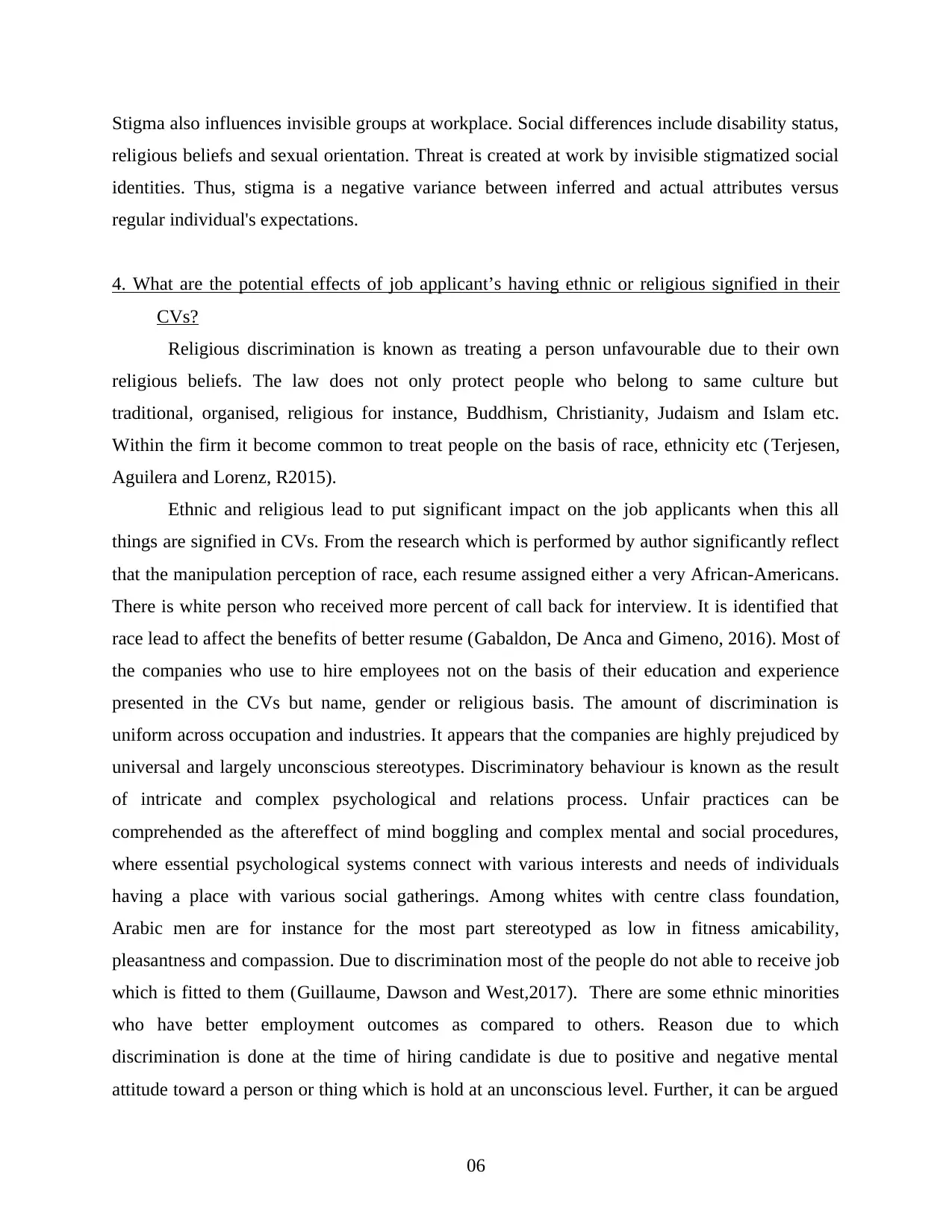
Stigma also influences invisible groups at workplace. Social differences include disability status,
religious beliefs and sexual orientation. Threat is created at work by invisible stigmatized social
identities. Thus, stigma is a negative variance between inferred and actual attributes versus
regular individual's expectations.
4. What are the potential effects of job applicant’s having ethnic or religious signified in their
CVs?
Religious discrimination is known as treating a person unfavourable due to their own
religious beliefs. The law does not only protect people who belong to same culture but
traditional, organised, religious for instance, Buddhism, Christianity, Judaism and Islam etc.
Within the firm it become common to treat people on the basis of race, ethnicity etc (Terjesen,
Aguilera and Lorenz, R2015).
Ethnic and religious lead to put significant impact on the job applicants when this all
things are signified in CVs. From the research which is performed by author significantly reflect
that the manipulation perception of race, each resume assigned either a very African-Americans.
There is white person who received more percent of call back for interview. It is identified that
race lead to affect the benefits of better resume (Gabaldon, De Anca and Gimeno, 2016). Most of
the companies who use to hire employees not on the basis of their education and experience
presented in the CVs but name, gender or religious basis. The amount of discrimination is
uniform across occupation and industries. It appears that the companies are highly prejudiced by
universal and largely unconscious stereotypes. Discriminatory behaviour is known as the result
of intricate and complex psychological and relations process. Unfair practices can be
comprehended as the aftereffect of mind boggling and complex mental and social procedures,
where essential psychological systems connect with various interests and needs of individuals
having a place with various social gatherings. Among whites with centre class foundation,
Arabic men are for instance for the most part stereotyped as low in fitness amicability,
pleasantness and compassion. Due to discrimination most of the people do not able to receive job
which is fitted to them (Guillaume, Dawson and West,2017). There are some ethnic minorities
who have better employment outcomes as compared to others. Reason due to which
discrimination is done at the time of hiring candidate is due to positive and negative mental
attitude toward a person or thing which is hold at an unconscious level. Further, it can be argued
06
religious beliefs and sexual orientation. Threat is created at work by invisible stigmatized social
identities. Thus, stigma is a negative variance between inferred and actual attributes versus
regular individual's expectations.
4. What are the potential effects of job applicant’s having ethnic or religious signified in their
CVs?
Religious discrimination is known as treating a person unfavourable due to their own
religious beliefs. The law does not only protect people who belong to same culture but
traditional, organised, religious for instance, Buddhism, Christianity, Judaism and Islam etc.
Within the firm it become common to treat people on the basis of race, ethnicity etc (Terjesen,
Aguilera and Lorenz, R2015).
Ethnic and religious lead to put significant impact on the job applicants when this all
things are signified in CVs. From the research which is performed by author significantly reflect
that the manipulation perception of race, each resume assigned either a very African-Americans.
There is white person who received more percent of call back for interview. It is identified that
race lead to affect the benefits of better resume (Gabaldon, De Anca and Gimeno, 2016). Most of
the companies who use to hire employees not on the basis of their education and experience
presented in the CVs but name, gender or religious basis. The amount of discrimination is
uniform across occupation and industries. It appears that the companies are highly prejudiced by
universal and largely unconscious stereotypes. Discriminatory behaviour is known as the result
of intricate and complex psychological and relations process. Unfair practices can be
comprehended as the aftereffect of mind boggling and complex mental and social procedures,
where essential psychological systems connect with various interests and needs of individuals
having a place with various social gatherings. Among whites with centre class foundation,
Arabic men are for instance for the most part stereotyped as low in fitness amicability,
pleasantness and compassion. Due to discrimination most of the people do not able to receive job
which is fitted to them (Guillaume, Dawson and West,2017). There are some ethnic minorities
who have better employment outcomes as compared to others. Reason due to which
discrimination is done at the time of hiring candidate is due to positive and negative mental
attitude toward a person or thing which is hold at an unconscious level. Further, it can be argued
06
⊘ This is a preview!⊘
Do you want full access?
Subscribe today to unlock all pages.

Trusted by 1+ million students worldwide
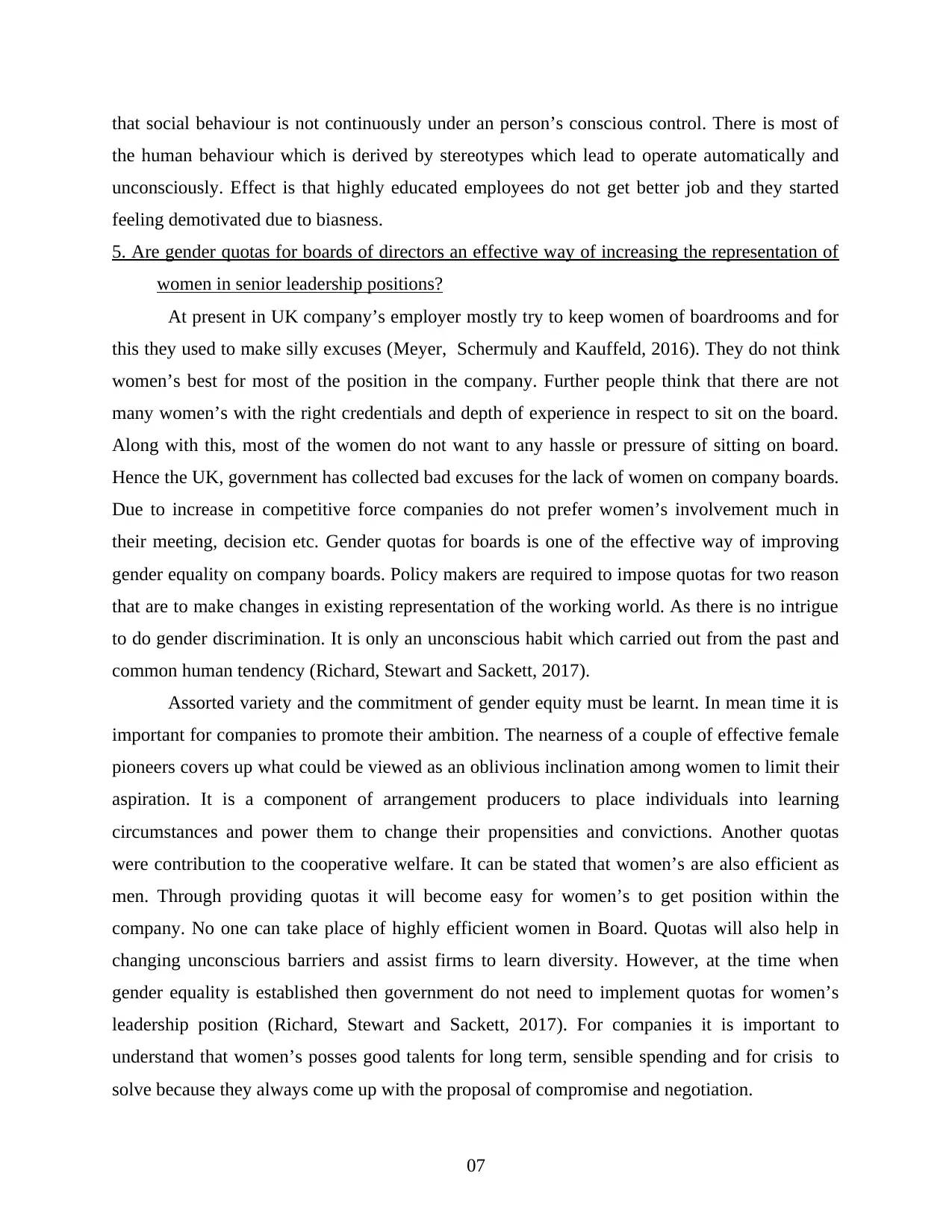
that social behaviour is not continuously under an person’s conscious control. There is most of
the human behaviour which is derived by stereotypes which lead to operate automatically and
unconsciously. Effect is that highly educated employees do not get better job and they started
feeling demotivated due to biasness.
5. Are gender quotas for boards of directors an effective way of increasing the representation of
women in senior leadership positions?
At present in UK company’s employer mostly try to keep women of boardrooms and for
this they used to make silly excuses (Meyer, Schermuly and Kauffeld, 2016). They do not think
women’s best for most of the position in the company. Further people think that there are not
many women’s with the right credentials and depth of experience in respect to sit on the board.
Along with this, most of the women do not want to any hassle or pressure of sitting on board.
Hence the UK, government has collected bad excuses for the lack of women on company boards.
Due to increase in competitive force companies do not prefer women’s involvement much in
their meeting, decision etc. Gender quotas for boards is one of the effective way of improving
gender equality on company boards. Policy makers are required to impose quotas for two reason
that are to make changes in existing representation of the working world. As there is no intrigue
to do gender discrimination. It is only an unconscious habit which carried out from the past and
common human tendency (Richard, Stewart and Sackett, 2017).
Assorted variety and the commitment of gender equity must be learnt. In mean time it is
important for companies to promote their ambition. The nearness of a couple of effective female
pioneers covers up what could be viewed as an oblivious inclination among women to limit their
aspiration. It is a component of arrangement producers to place individuals into learning
circumstances and power them to change their propensities and convictions. Another quotas
were contribution to the cooperative welfare. It can be stated that women’s are also efficient as
men. Through providing quotas it will become easy for women’s to get position within the
company. No one can take place of highly efficient women in Board. Quotas will also help in
changing unconscious barriers and assist firms to learn diversity. However, at the time when
gender equality is established then government do not need to implement quotas for women’s
leadership position (Richard, Stewart and Sackett, 2017). For companies it is important to
understand that women’s posses good talents for long term, sensible spending and for crisis to
solve because they always come up with the proposal of compromise and negotiation.
07
the human behaviour which is derived by stereotypes which lead to operate automatically and
unconsciously. Effect is that highly educated employees do not get better job and they started
feeling demotivated due to biasness.
5. Are gender quotas for boards of directors an effective way of increasing the representation of
women in senior leadership positions?
At present in UK company’s employer mostly try to keep women of boardrooms and for
this they used to make silly excuses (Meyer, Schermuly and Kauffeld, 2016). They do not think
women’s best for most of the position in the company. Further people think that there are not
many women’s with the right credentials and depth of experience in respect to sit on the board.
Along with this, most of the women do not want to any hassle or pressure of sitting on board.
Hence the UK, government has collected bad excuses for the lack of women on company boards.
Due to increase in competitive force companies do not prefer women’s involvement much in
their meeting, decision etc. Gender quotas for boards is one of the effective way of improving
gender equality on company boards. Policy makers are required to impose quotas for two reason
that are to make changes in existing representation of the working world. As there is no intrigue
to do gender discrimination. It is only an unconscious habit which carried out from the past and
common human tendency (Richard, Stewart and Sackett, 2017).
Assorted variety and the commitment of gender equity must be learnt. In mean time it is
important for companies to promote their ambition. The nearness of a couple of effective female
pioneers covers up what could be viewed as an oblivious inclination among women to limit their
aspiration. It is a component of arrangement producers to place individuals into learning
circumstances and power them to change their propensities and convictions. Another quotas
were contribution to the cooperative welfare. It can be stated that women’s are also efficient as
men. Through providing quotas it will become easy for women’s to get position within the
company. No one can take place of highly efficient women in Board. Quotas will also help in
changing unconscious barriers and assist firms to learn diversity. However, at the time when
gender equality is established then government do not need to implement quotas for women’s
leadership position (Richard, Stewart and Sackett, 2017). For companies it is important to
understand that women’s posses good talents for long term, sensible spending and for crisis to
solve because they always come up with the proposal of compromise and negotiation.
07
Paraphrase This Document
Need a fresh take? Get an instant paraphrase of this document with our AI Paraphraser
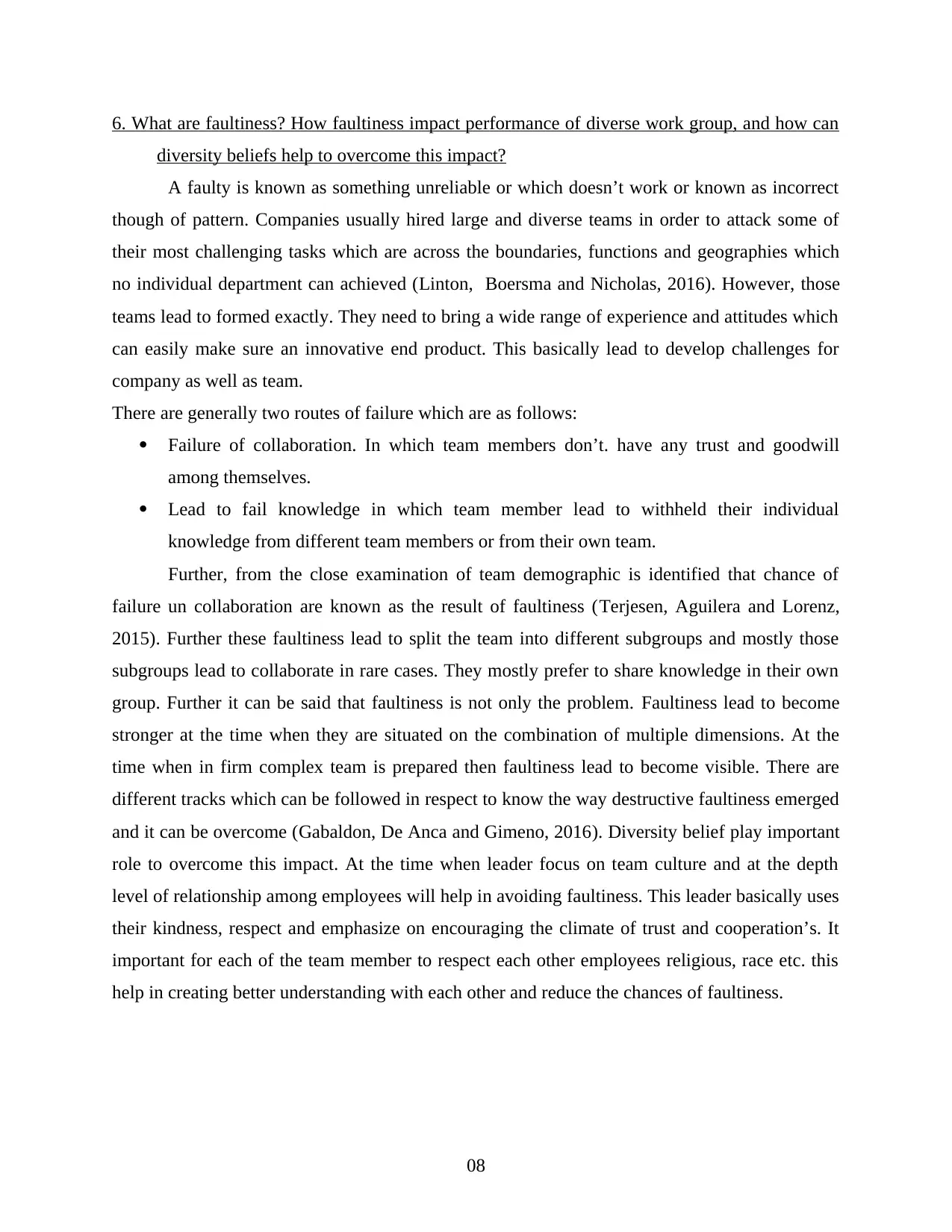
6. What are faultiness? How faultiness impact performance of diverse work group, and how can
diversity beliefs help to overcome this impact?
A faulty is known as something unreliable or which doesn’t work or known as incorrect
though of pattern. Companies usually hired large and diverse teams in order to attack some of
their most challenging tasks which are across the boundaries, functions and geographies which
no individual department can achieved (Linton, Boersma and Nicholas, 2016). However, those
teams lead to formed exactly. They need to bring a wide range of experience and attitudes which
can easily make sure an innovative end product. This basically lead to develop challenges for
company as well as team.
There are generally two routes of failure which are as follows:
Failure of collaboration. In which team members don’t. have any trust and goodwill
among themselves.
Lead to fail knowledge in which team member lead to withheld their individual
knowledge from different team members or from their own team.
Further, from the close examination of team demographic is identified that chance of
failure un collaboration are known as the result of faultiness (Terjesen, Aguilera and Lorenz,
2015). Further these faultiness lead to split the team into different subgroups and mostly those
subgroups lead to collaborate in rare cases. They mostly prefer to share knowledge in their own
group. Further it can be said that faultiness is not only the problem. Faultiness lead to become
stronger at the time when they are situated on the combination of multiple dimensions. At the
time when in firm complex team is prepared then faultiness lead to become visible. There are
different tracks which can be followed in respect to know the way destructive faultiness emerged
and it can be overcome (Gabaldon, De Anca and Gimeno, 2016). Diversity belief play important
role to overcome this impact. At the time when leader focus on team culture and at the depth
level of relationship among employees will help in avoiding faultiness. This leader basically uses
their kindness, respect and emphasize on encouraging the climate of trust and cooperation’s. It
important for each of the team member to respect each other employees religious, race etc. this
help in creating better understanding with each other and reduce the chances of faultiness.
08
diversity beliefs help to overcome this impact?
A faulty is known as something unreliable or which doesn’t work or known as incorrect
though of pattern. Companies usually hired large and diverse teams in order to attack some of
their most challenging tasks which are across the boundaries, functions and geographies which
no individual department can achieved (Linton, Boersma and Nicholas, 2016). However, those
teams lead to formed exactly. They need to bring a wide range of experience and attitudes which
can easily make sure an innovative end product. This basically lead to develop challenges for
company as well as team.
There are generally two routes of failure which are as follows:
Failure of collaboration. In which team members don’t. have any trust and goodwill
among themselves.
Lead to fail knowledge in which team member lead to withheld their individual
knowledge from different team members or from their own team.
Further, from the close examination of team demographic is identified that chance of
failure un collaboration are known as the result of faultiness (Terjesen, Aguilera and Lorenz,
2015). Further these faultiness lead to split the team into different subgroups and mostly those
subgroups lead to collaborate in rare cases. They mostly prefer to share knowledge in their own
group. Further it can be said that faultiness is not only the problem. Faultiness lead to become
stronger at the time when they are situated on the combination of multiple dimensions. At the
time when in firm complex team is prepared then faultiness lead to become visible. There are
different tracks which can be followed in respect to know the way destructive faultiness emerged
and it can be overcome (Gabaldon, De Anca and Gimeno, 2016). Diversity belief play important
role to overcome this impact. At the time when leader focus on team culture and at the depth
level of relationship among employees will help in avoiding faultiness. This leader basically uses
their kindness, respect and emphasize on encouraging the climate of trust and cooperation’s. It
important for each of the team member to respect each other employees religious, race etc. this
help in creating better understanding with each other and reduce the chances of faultiness.
08
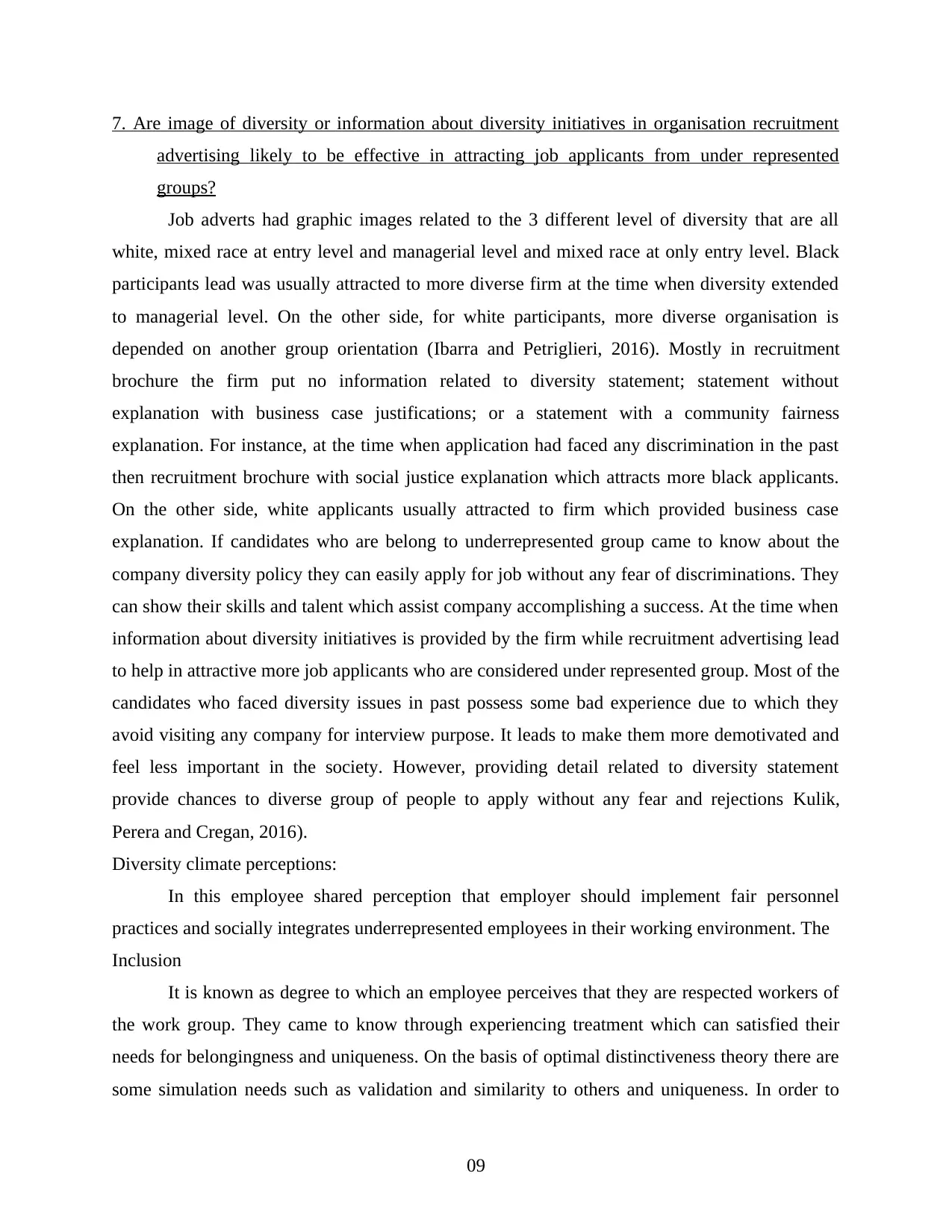
7. Are image of diversity or information about diversity initiatives in organisation recruitment
advertising likely to be effective in attracting job applicants from under represented
groups?
Job adverts had graphic images related to the 3 different level of diversity that are all
white, mixed race at entry level and managerial level and mixed race at only entry level. Black
participants lead was usually attracted to more diverse firm at the time when diversity extended
to managerial level. On the other side, for white participants, more diverse organisation is
depended on another group orientation (Ibarra and Petriglieri, 2016). Mostly in recruitment
brochure the firm put no information related to diversity statement; statement without
explanation with business case justifications; or a statement with a community fairness
explanation. For instance, at the time when application had faced any discrimination in the past
then recruitment brochure with social justice explanation which attracts more black applicants.
On the other side, white applicants usually attracted to firm which provided business case
explanation. If candidates who are belong to underrepresented group came to know about the
company diversity policy they can easily apply for job without any fear of discriminations. They
can show their skills and talent which assist company accomplishing a success. At the time when
information about diversity initiatives is provided by the firm while recruitment advertising lead
to help in attractive more job applicants who are considered under represented group. Most of the
candidates who faced diversity issues in past possess some bad experience due to which they
avoid visiting any company for interview purpose. It leads to make them more demotivated and
feel less important in the society. However, providing detail related to diversity statement
provide chances to diverse group of people to apply without any fear and rejections Kulik,
Perera and Cregan, 2016).
Diversity climate perceptions:
In this employee shared perception that employer should implement fair personnel
practices and socially integrates underrepresented employees in their working environment. The
Inclusion
It is known as degree to which an employee perceives that they are respected workers of
the work group. They came to know through experiencing treatment which can satisfied their
needs for belongingness and uniqueness. On the basis of optimal distinctiveness theory there are
some simulation needs such as validation and similarity to others and uniqueness. In order to
09
advertising likely to be effective in attracting job applicants from under represented
groups?
Job adverts had graphic images related to the 3 different level of diversity that are all
white, mixed race at entry level and managerial level and mixed race at only entry level. Black
participants lead was usually attracted to more diverse firm at the time when diversity extended
to managerial level. On the other side, for white participants, more diverse organisation is
depended on another group orientation (Ibarra and Petriglieri, 2016). Mostly in recruitment
brochure the firm put no information related to diversity statement; statement without
explanation with business case justifications; or a statement with a community fairness
explanation. For instance, at the time when application had faced any discrimination in the past
then recruitment brochure with social justice explanation which attracts more black applicants.
On the other side, white applicants usually attracted to firm which provided business case
explanation. If candidates who are belong to underrepresented group came to know about the
company diversity policy they can easily apply for job without any fear of discriminations. They
can show their skills and talent which assist company accomplishing a success. At the time when
information about diversity initiatives is provided by the firm while recruitment advertising lead
to help in attractive more job applicants who are considered under represented group. Most of the
candidates who faced diversity issues in past possess some bad experience due to which they
avoid visiting any company for interview purpose. It leads to make them more demotivated and
feel less important in the society. However, providing detail related to diversity statement
provide chances to diverse group of people to apply without any fear and rejections Kulik,
Perera and Cregan, 2016).
Diversity climate perceptions:
In this employee shared perception that employer should implement fair personnel
practices and socially integrates underrepresented employees in their working environment. The
Inclusion
It is known as degree to which an employee perceives that they are respected workers of
the work group. They came to know through experiencing treatment which can satisfied their
needs for belongingness and uniqueness. On the basis of optimal distinctiveness theory there are
some simulation needs such as validation and similarity to others and uniqueness. In order to
09
⊘ This is a preview!⊘
Do you want full access?
Subscribe today to unlock all pages.

Trusted by 1+ million students worldwide
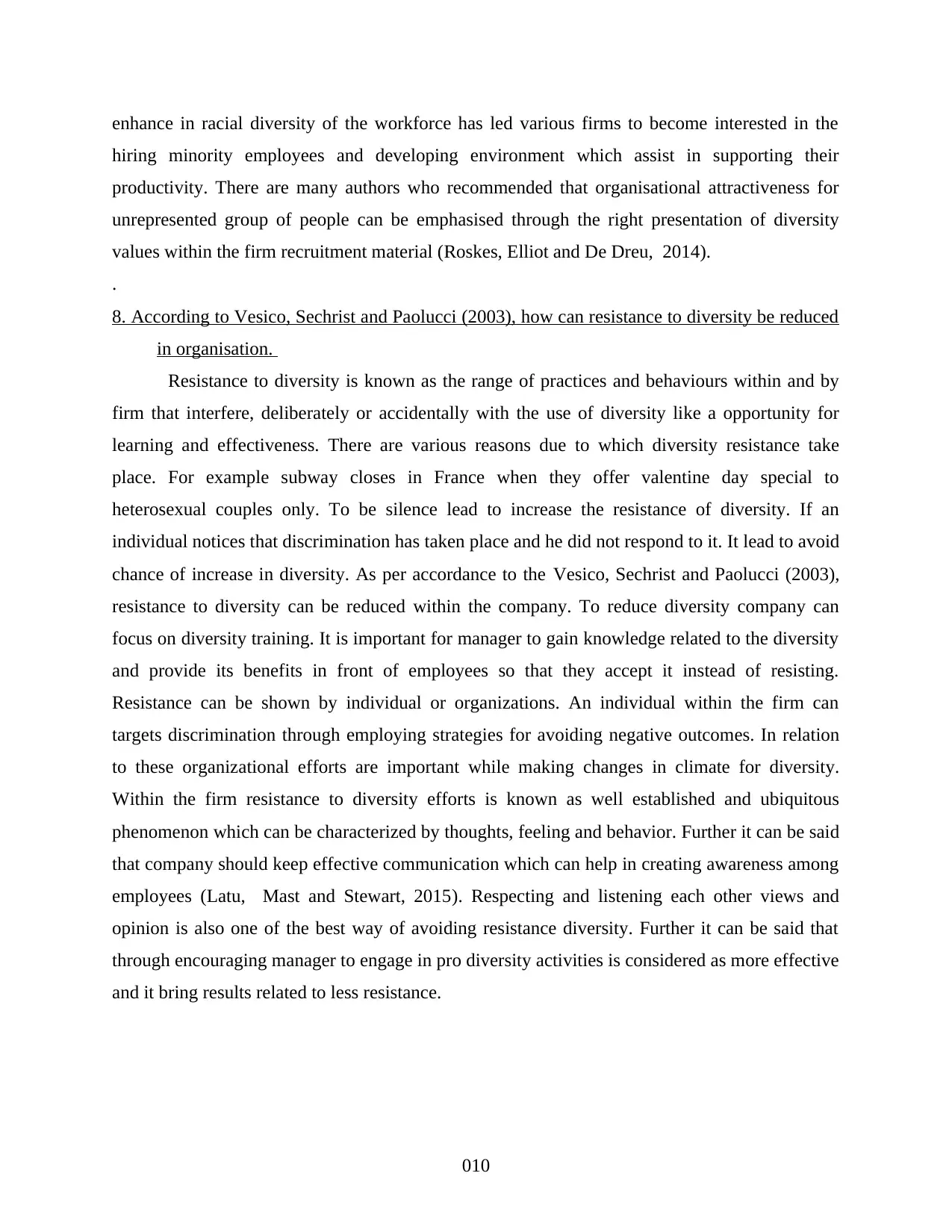
enhance in racial diversity of the workforce has led various firms to become interested in the
hiring minority employees and developing environment which assist in supporting their
productivity. There are many authors who recommended that organisational attractiveness for
unrepresented group of people can be emphasised through the right presentation of diversity
values within the firm recruitment material (Roskes, Elliot and De Dreu, 2014).
.
8. According to Vesico, Sechrist and Paolucci (2003), how can resistance to diversity be reduced
in organisation.
Resistance to diversity is known as the range of practices and behaviours within and by
firm that interfere, deliberately or accidentally with the use of diversity like a opportunity for
learning and effectiveness. There are various reasons due to which diversity resistance take
place. For example subway closes in France when they offer valentine day special to
heterosexual couples only. To be silence lead to increase the resistance of diversity. If an
individual notices that discrimination has taken place and he did not respond to it. It lead to avoid
chance of increase in diversity. As per accordance to the Vesico, Sechrist and Paolucci (2003),
resistance to diversity can be reduced within the company. To reduce diversity company can
focus on diversity training. It is important for manager to gain knowledge related to the diversity
and provide its benefits in front of employees so that they accept it instead of resisting.
Resistance can be shown by individual or organizations. An individual within the firm can
targets discrimination through employing strategies for avoiding negative outcomes. In relation
to these organizational efforts are important while making changes in climate for diversity.
Within the firm resistance to diversity efforts is known as well established and ubiquitous
phenomenon which can be characterized by thoughts, feeling and behavior. Further it can be said
that company should keep effective communication which can help in creating awareness among
employees (Latu, Mast and Stewart, 2015). Respecting and listening each other views and
opinion is also one of the best way of avoiding resistance diversity. Further it can be said that
through encouraging manager to engage in pro diversity activities is considered as more effective
and it bring results related to less resistance.
010
hiring minority employees and developing environment which assist in supporting their
productivity. There are many authors who recommended that organisational attractiveness for
unrepresented group of people can be emphasised through the right presentation of diversity
values within the firm recruitment material (Roskes, Elliot and De Dreu, 2014).
.
8. According to Vesico, Sechrist and Paolucci (2003), how can resistance to diversity be reduced
in organisation.
Resistance to diversity is known as the range of practices and behaviours within and by
firm that interfere, deliberately or accidentally with the use of diversity like a opportunity for
learning and effectiveness. There are various reasons due to which diversity resistance take
place. For example subway closes in France when they offer valentine day special to
heterosexual couples only. To be silence lead to increase the resistance of diversity. If an
individual notices that discrimination has taken place and he did not respond to it. It lead to avoid
chance of increase in diversity. As per accordance to the Vesico, Sechrist and Paolucci (2003),
resistance to diversity can be reduced within the company. To reduce diversity company can
focus on diversity training. It is important for manager to gain knowledge related to the diversity
and provide its benefits in front of employees so that they accept it instead of resisting.
Resistance can be shown by individual or organizations. An individual within the firm can
targets discrimination through employing strategies for avoiding negative outcomes. In relation
to these organizational efforts are important while making changes in climate for diversity.
Within the firm resistance to diversity efforts is known as well established and ubiquitous
phenomenon which can be characterized by thoughts, feeling and behavior. Further it can be said
that company should keep effective communication which can help in creating awareness among
employees (Latu, Mast and Stewart, 2015). Respecting and listening each other views and
opinion is also one of the best way of avoiding resistance diversity. Further it can be said that
through encouraging manager to engage in pro diversity activities is considered as more effective
and it bring results related to less resistance.
010
Paraphrase This Document
Need a fresh take? Get an instant paraphrase of this document with our AI Paraphraser

011
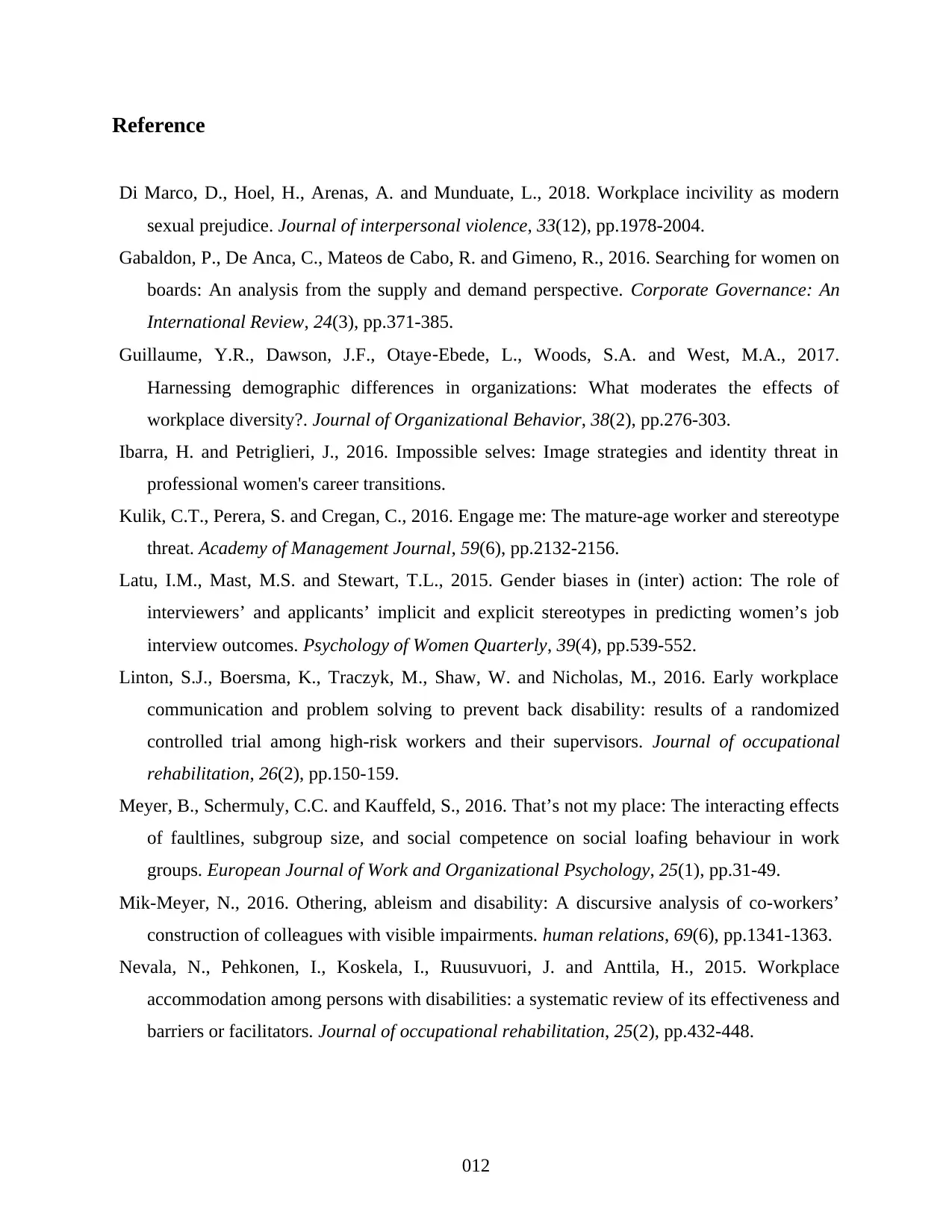
Reference
Di Marco, D., Hoel, H., Arenas, A. and Munduate, L., 2018. Workplace incivility as modern
sexual prejudice. Journal of interpersonal violence, 33(12), pp.1978-2004.
Gabaldon, P., De Anca, C., Mateos de Cabo, R. and Gimeno, R., 2016. Searching for women on
boards: An analysis from the supply and demand perspective. Corporate Governance: An
International Review, 24(3), pp.371-385.
Guillaume, Y.R., Dawson, J.F., Otaye‐Ebede, L., Woods, S.A. and West, M.A., 2017.
Harnessing demographic differences in organizations: What moderates the effects of
workplace diversity?. Journal of Organizational Behavior, 38(2), pp.276-303.
Ibarra, H. and Petriglieri, J., 2016. Impossible selves: Image strategies and identity threat in
professional women's career transitions.
Kulik, C.T., Perera, S. and Cregan, C., 2016. Engage me: The mature-age worker and stereotype
threat. Academy of Management Journal, 59(6), pp.2132-2156.
Latu, I.M., Mast, M.S. and Stewart, T.L., 2015. Gender biases in (inter) action: The role of
interviewers’ and applicants’ implicit and explicit stereotypes in predicting women’s job
interview outcomes. Psychology of Women Quarterly, 39(4), pp.539-552.
Linton, S.J., Boersma, K., Traczyk, M., Shaw, W. and Nicholas, M., 2016. Early workplace
communication and problem solving to prevent back disability: results of a randomized
controlled trial among high-risk workers and their supervisors. Journal of occupational
rehabilitation, 26(2), pp.150-159.
Meyer, B., Schermuly, C.C. and Kauffeld, S., 2016. That’s not my place: The interacting effects
of faultlines, subgroup size, and social competence on social loafing behaviour in work
groups. European Journal of Work and Organizational Psychology, 25(1), pp.31-49.
Mik-Meyer, N., 2016. Othering, ableism and disability: A discursive analysis of co-workers’
construction of colleagues with visible impairments. human relations, 69(6), pp.1341-1363.
Nevala, N., Pehkonen, I., Koskela, I., Ruusuvuori, J. and Anttila, H., 2015. Workplace
accommodation among persons with disabilities: a systematic review of its effectiveness and
barriers or facilitators. Journal of occupational rehabilitation, 25(2), pp.432-448.
012
Di Marco, D., Hoel, H., Arenas, A. and Munduate, L., 2018. Workplace incivility as modern
sexual prejudice. Journal of interpersonal violence, 33(12), pp.1978-2004.
Gabaldon, P., De Anca, C., Mateos de Cabo, R. and Gimeno, R., 2016. Searching for women on
boards: An analysis from the supply and demand perspective. Corporate Governance: An
International Review, 24(3), pp.371-385.
Guillaume, Y.R., Dawson, J.F., Otaye‐Ebede, L., Woods, S.A. and West, M.A., 2017.
Harnessing demographic differences in organizations: What moderates the effects of
workplace diversity?. Journal of Organizational Behavior, 38(2), pp.276-303.
Ibarra, H. and Petriglieri, J., 2016. Impossible selves: Image strategies and identity threat in
professional women's career transitions.
Kulik, C.T., Perera, S. and Cregan, C., 2016. Engage me: The mature-age worker and stereotype
threat. Academy of Management Journal, 59(6), pp.2132-2156.
Latu, I.M., Mast, M.S. and Stewart, T.L., 2015. Gender biases in (inter) action: The role of
interviewers’ and applicants’ implicit and explicit stereotypes in predicting women’s job
interview outcomes. Psychology of Women Quarterly, 39(4), pp.539-552.
Linton, S.J., Boersma, K., Traczyk, M., Shaw, W. and Nicholas, M., 2016. Early workplace
communication and problem solving to prevent back disability: results of a randomized
controlled trial among high-risk workers and their supervisors. Journal of occupational
rehabilitation, 26(2), pp.150-159.
Meyer, B., Schermuly, C.C. and Kauffeld, S., 2016. That’s not my place: The interacting effects
of faultlines, subgroup size, and social competence on social loafing behaviour in work
groups. European Journal of Work and Organizational Psychology, 25(1), pp.31-49.
Mik-Meyer, N., 2016. Othering, ableism and disability: A discursive analysis of co-workers’
construction of colleagues with visible impairments. human relations, 69(6), pp.1341-1363.
Nevala, N., Pehkonen, I., Koskela, I., Ruusuvuori, J. and Anttila, H., 2015. Workplace
accommodation among persons with disabilities: a systematic review of its effectiveness and
barriers or facilitators. Journal of occupational rehabilitation, 25(2), pp.432-448.
012
⊘ This is a preview!⊘
Do you want full access?
Subscribe today to unlock all pages.

Trusted by 1+ million students worldwide
1 out of 13
Related Documents
Your All-in-One AI-Powered Toolkit for Academic Success.
+13062052269
info@desklib.com
Available 24*7 on WhatsApp / Email
![[object Object]](/_next/static/media/star-bottom.7253800d.svg)
Unlock your academic potential
Copyright © 2020–2025 A2Z Services. All Rights Reserved. Developed and managed by ZUCOL.





